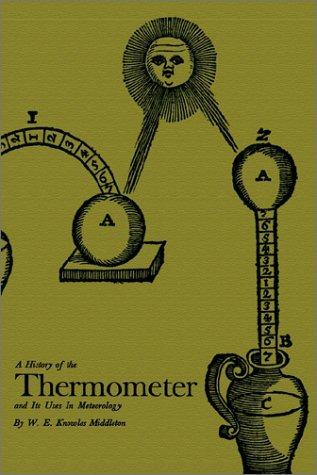Explore: Thermometer
Discover books, insights, and more — all in one place.
Learn more about Thermometer with top reads curated from trusted sources — all in one place.
AI-Generated Overview About “thermometer”:
Books Results
Source: The Open Library
The Open Library Search Results
Search results from The Open Library
1A history of the thermometer and its use in meteorology
By W. E. Knowles Middleton

“A history of the thermometer and its use in meteorology” Metadata:
- Title: ➤ A history of the thermometer and its use in meteorology
- Author: W. E. Knowles Middleton
- Language: English
- Number of Pages: Median: 249
- Publisher: ➤ UMI Books on Demand - Johns Hopkins Press - Johns Hopkins - The Johns Hopkins University Press
- Publish Date: 1966 - 1996 - 2002
- Publish Location: Baltimore
“A history of the thermometer and its use in meteorology” Subjects and Themes:
- Subjects: ➤ History - Thermometers - Atmospheric temperature - Measurement - Temperature measurements - Thermometers and thermometry - Meteorological Factors - Thermométrie - Histoire - Météorologie - Instruments - Geschichte - Thermometer - Thermometrie - Meteorologie
Edition Identifiers:
- The Open Library ID: OL21815403M - OL5992714M - OL7870985M - OL9374934M
- Online Computer Library Center (OCLC) ID: 34362856 - 413443
- Library of Congress Control Number (LCCN): 66023978
- All ISBNs: 0317519751 - 9780317519754 - 0801871530 - 9780801871535
First Setence:
"The opposition of "hot" and "cold," like that of "dry" and "moist," is an inevitable by-product of our sense of touch."
Access and General Info:
- First Year Published: 1966
- Is Full Text Available: No
- Is The Book Public: No
- Access Status: No_ebook
Online Access
Downloads Are Not Available:
The book is not public therefore the download links will not allow the download of the entire book, however, borrowing the book online is available.
Online Borrowing:
Online Marketplaces
Find A history of the thermometer and its use in meteorology at online marketplaces:
- Amazon: Audiable, Kindle and printed editions.
- Ebay: New & used books.
2Biennial Report
By Missouri Board of Immigration, Board of Immigration and Missouri

“Biennial Report” Metadata:
- Title: Biennial Report
- Authors: Missouri Board of ImmigrationBoard of ImmigrationMissouri
- Publish Date: 1867
“Biennial Report” Subjects and Themes:
- Subjects: ➤ missouri - louis - thermometer - board - immigration - tlie - lands - going - railroad - average - relative humidity - north missouri - fair days - pacific railroad - variable days - iron mountain - government lands - barometrical pressure - average crop - louis county
Edition Identifiers:
- The Open Library ID: OL20463896M
- Online Computer Library Center (OCLC) ID: 17152226
Access and General Info:
- First Year Published: 1867
- Is Full Text Available: Yes
- Is The Book Public: Yes
- Access Status: Public
Online Access
Online Borrowing:
- Borrowing from Open Library: Borrowing link
- Borrowing from Archive.org: Borrowing link
Online Marketplaces
Find Biennial Report at online marketplaces:
- Amazon: Audiable, Kindle and printed editions.
- Ebay: New & used books.